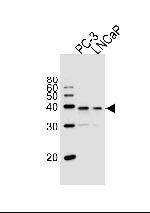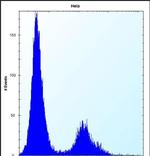Search Thermo Fisher Scientific
FIGURE: 1 / 2
VDR Antibody (PA5-35156) in WB


Product Details
PA5-35156
Species Reactivity
Host/Isotype
Class
Type
Immunogen
Conjugate
Form
Purification
Storage buffer
Contains
Storage conditions
Shipping conditions
RRID
Target Information
Steroid receptors are ligand-dependent intracellular proteins that stimulate transcription of specific genes by binding to specific DNA sequences following activation by the appropriate hormone. The 1,25-dihydroxy-vitamin D3 receptor (VDR) belongs to the superfamily of steroid hormone receptors which includes estrogen, progesterone, glucocorticoid, androgen, and thyroid hormone receptors. Vitamin D modulates calcium and phosphorus homeostasis, bone remodeling, cell growth regulation, and differentiation. Studies have found VDR in the intestine, bone, kidney, epidermis, and cells of the endocrine immune system. Repression of T-cell proliferation and interleukin-2 (IL-2) gene expression, for example, occurs when VDR binds within the IL-2 enhancer. Formation of VDR/retinoic X receptor (RXR) heterodimers in the presence of intracellular 1,25(OH)2D3 has been shown to interfere with assembly of nuclear factor of activated T-cells (NFATp)/Fos/Jun/DNA complex and subsequent IL-2 gene transcription. The corresponding gene for the vitamin D receptor is NR1I1.
For Research Use Only. Not for use in diagnostic procedures. Not for resale without express authorization.
References (0)
Bioinformatics
Protein Aliases: 1,25-dihydroxyvitamin D3 receptor; HGNC:12679; Nuclear receptor subfamily 1 group I member 1; protein phosphatase 1, regulatory subunit 163; VDR; vitamin D nuclear receptor variant 1; vitamin D receptor; Vitamin D3 receptor
Gene Aliases: NR1I1; PPP1R163; VDR
UniProt ID: (Human) P11473
Entrez Gene ID: (Human) 7421

Performance Guarantee
If an Invitrogen™ antibody doesn't perform as described on our website or datasheet,we'll replace the product at no cost to you, or provide you with a credit for a future purchase.*
Learn more
We're here to help
Get expert recommendations for common problems or connect directly with an on staff expert for technical assistance related to applications, equipment and general product use.
Contact tech support
